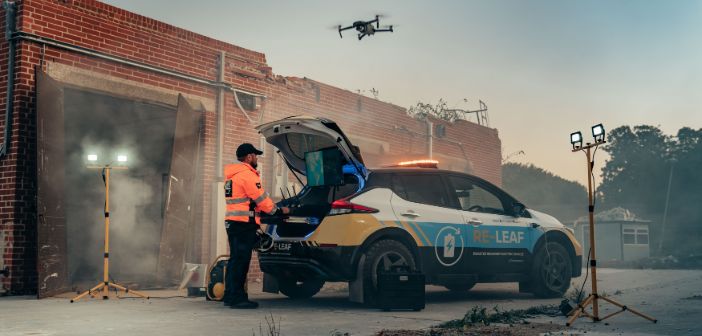Nissan has revealed an emergency response EV concept designed to provide emergency power in a natural disaster.
The Re-Leaf working prototype is based on the Nissan Leaf passenger car but has been remodelled to include underfloor protection, wider tracks and all terrain tyres.
The battery-electric vehicle also features weatherproof plug sockets mounted directly to the exterior of the vehicle, which enable 110-230V devices to be powered from the car’s high-capacity lithium-ion battery.
Nissan said the Re-Leaf can be driven into the centre of a disaster zone, navigating debris, and provide a fully mobile power supply to aid the recovery process. Furthermore, an integrated energy management system can run lighting, medical applications, communications and other life-supporting systems.

According to Nissan, the vehicle is a “portable power station” with a fully charged 62kWh battery, which can provide enough electricity to power the average UK household for around six days.
The Re-Leaf uses the Leaf’s bi-directional charging ability, allowing the EV to not only ‘pull’ power to recharge the battery, but also to ‘push’ it back to the grid through V2G (vehicle-to-grid) technology, or directly to electronic devices through V2X (vehicle-to-everything).
The company said the concept has been designed to showcase the ability of EVs to provide mobile emergency power as, following a natural disaster, the time for electricity supply to be restored is typically 24-48 hours, depending on the severity of the damage.
When power is restored, a recharged Re-Leaf can provide zero-emission transport up to 239 miles on a single charge.
Helen Perry, head of electric passenger cars and infrastructure for Nissan Europe, said: “Concepts like the Re-Leaf show the possible application of EVs in disaster management and demonstrate that smarter, cleaner technology can help save lives and provide greater resilience for the future.
“Electric vehicles are emerging as one of the technologies that can improve resilience in the power sector. By having thousands of EVs available on standby, either as disaster-support vehicles or plugged into the network through V2G, they’re uniquely capable of creating a virtual power plant to maintain a supply of energy during a major outage.”




